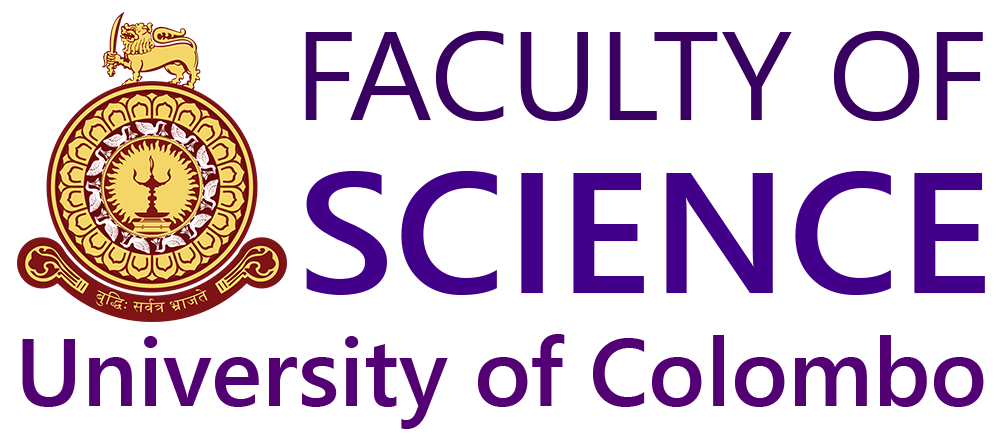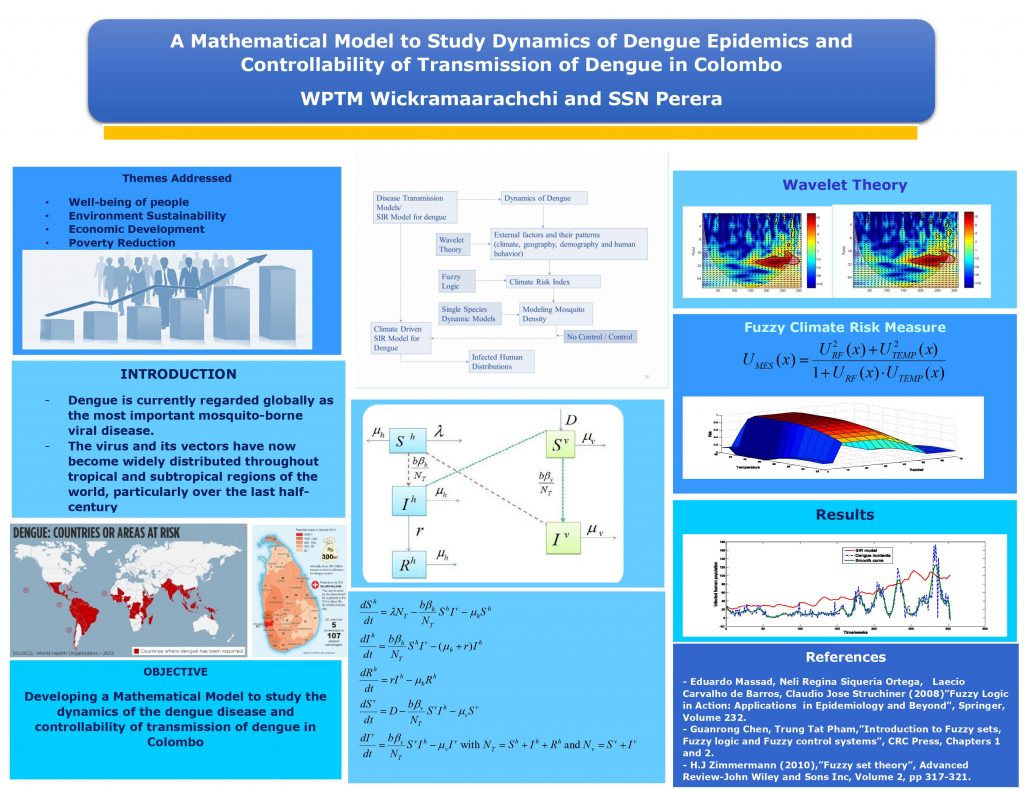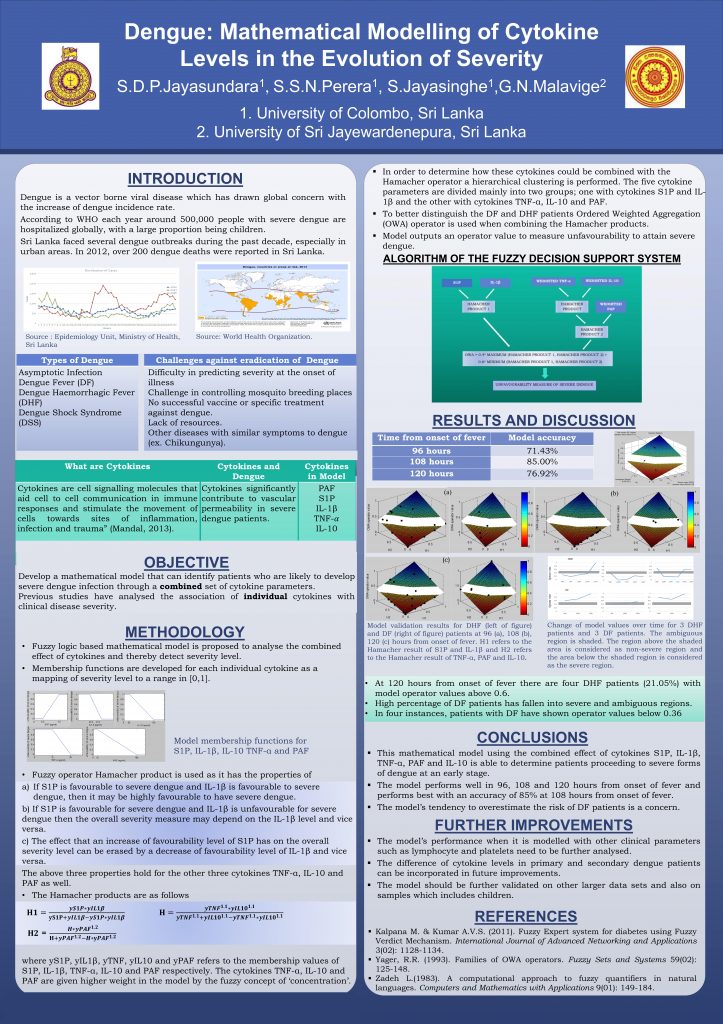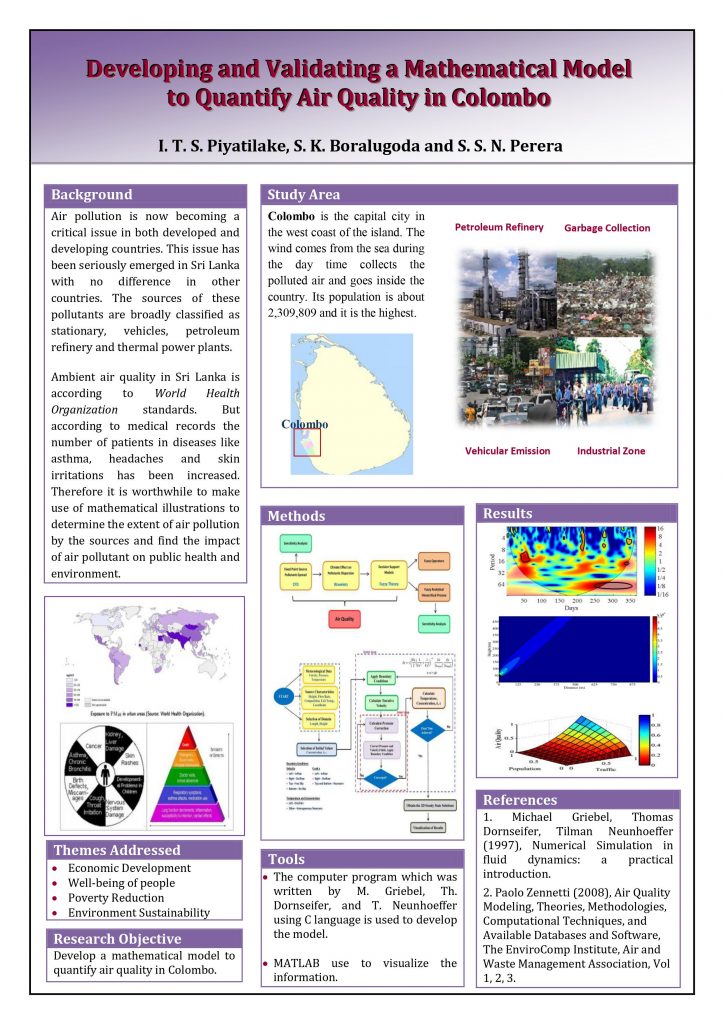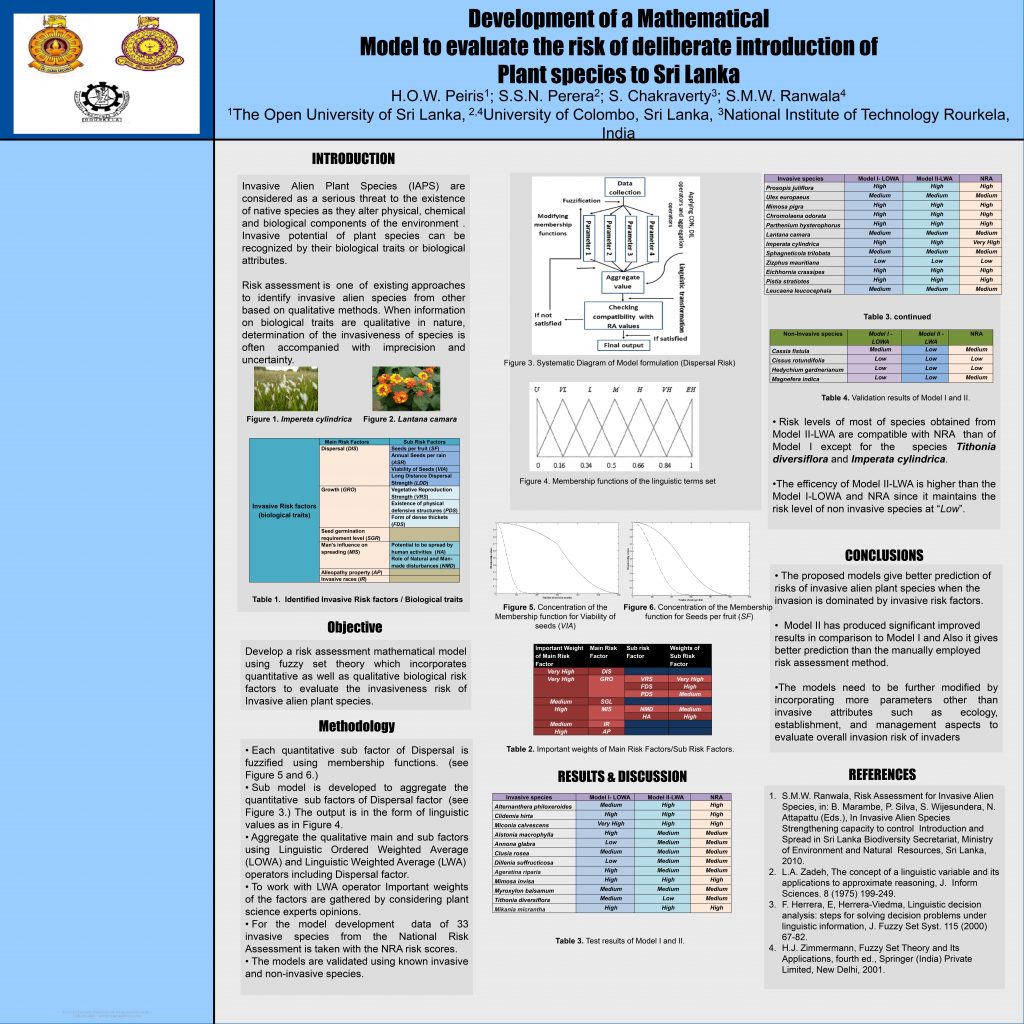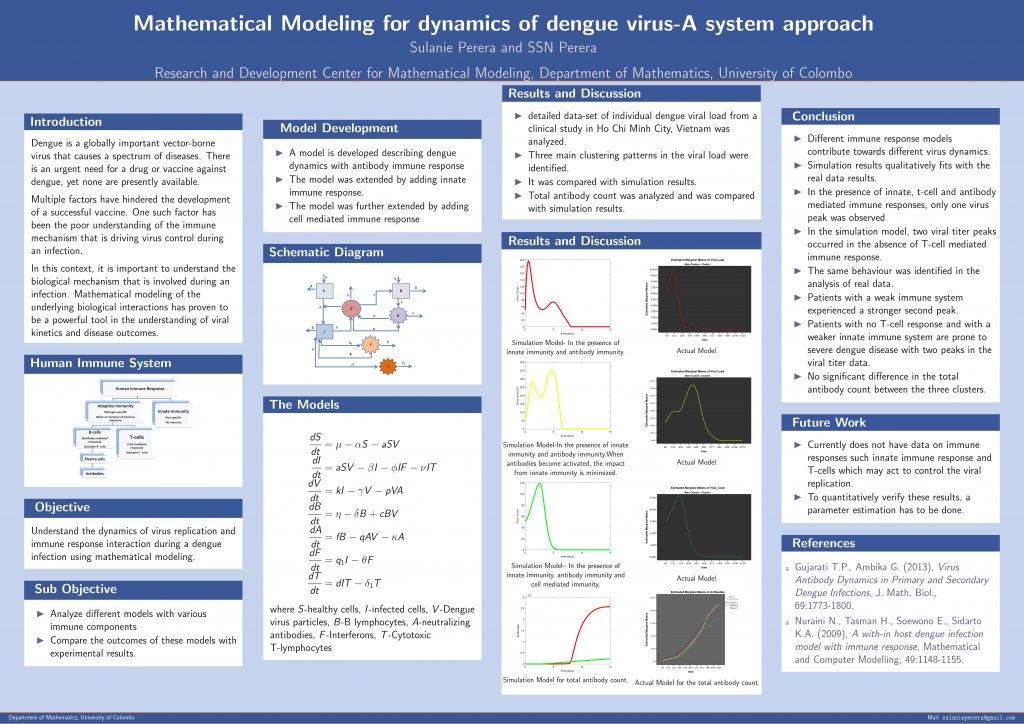A Mathematical Model to Study Dynamics of Dengue Epidemics and Controllability of Transmission of Dengue in Colombo
Team : Dr. S. S. N. Perera, Dr. W. P. T. M. Wickramaarachchi
Dengue disease, which is a mosquito-borne disease, has been an important public health problem specially in the tropical and subtropical regions in the world. Neither vaccine nor successful treatment has been found yet to dengue disease. Therefore prevention and control play a vital role in minimizing the risk of dengue and its burden from the vulnerable populations. Mathematical models of dengue with xed parameters do not completely describe the dynamics of the dengue transmission since the dynamics of dengue depend on various external factors such as climate, human mobility, geography and demography. This project wavelet tool was used to analyze dengue data and identify the correlation between dengue and climate factors. Fuzzy based climate index was developed and which was incorporated into the classical SIR model.
For more details
Dengue: Mathematical Modelling of Cytokine Levels in the Evolution of Severity
Team : Dr. S. S. N. Perera, Dr. P. Jayasundara, Prof. G. Malavige, Prof. S. Jayasinghe
Background: Dengue causes considerable morbidity and mortality in Sri Lanka. Immune mediated and cytokine related factors contribute to its evolution from an asymptotic infection to severe forms of dengue. Previous studies have analysed the association of individual cytokines with clinical disease severity. In contrast, we have viewed this evolution to severe dengue as the behaviour of a complex dynamic system. We therefore analysed the combined effect of multiple cytokines that interact dynamically with each other in order to generate a mathematical model to predict the occurrence of severe dengue. We expect this to have predictive value in detecting severe cases and improve outcomes. Methods & Materials: We analysed data on 11 adult patients with dengue fever (DF) and 25 patients with dengue haemorrhagic fever (DHF) recruited from the Colombo South Teaching Hospital, Sri Lanka. Platelet activating factor (PAF), sphingosine 1-phosphatase (S1P), IL1, TNF and IL10 were used as the cytokine parameters for the model. Hierarchical clustering was used to detect factors that correlated with each other. Their interactions were mapped using Fuzzy Logic mechanisms with the combination of Hamacher and OWA operators. Results: Clustering indicated that S1P and IL1 levels were associated with each other. Since, PAF, IL-10 and TNF-have shown to associate with severe dengue, they were combined together by allocating these cytokines a higher prominence in the model. Operator value below 0.3 in the overall model correctly predicted development of DHF with 76.6% accuracy.
For more details
Mathematical Modelling of Immune Parameters in the Evolution of Severe Dengue
Team : Dr. S. S. N. Perera, Prof. G. N. Malavige, Prof. S. Jayasinghe, Dr. M. K. Premaratne
Aims: Predicting the risk of severity at an early stage in an individual patient will be invaluable in preventing morbidity and mortality caused by dengue. We hypothesized that such predictions are possible by analyzing multiple parameters using mathematical modeling. Methodology. Data from 11 adult patients with dengue fever (DF) and 25 patients with dengue hemorrhagic fever (DHF) were analyzed. Multivariate statistical analysis was performed to study the characteristics and interactions of parameters using dengue NS1 antigen levels, dengue IgG antibody levels, platelet counts, and lymphocyte counts. Fuzzy logic fundamentals were used to map the risk of developing severe forms of dengue. The cumulative effects of the parameters were incorporated using the Hamacher and the OWA operators. Results. The operator classified the patients according to the severity level during the time period of 96 hours to 120 hours after the onset of fever. The accuracy ranged from 53% to 89%. Conclusion. The results show a robust mathematical model that explains the evolution from dengue to its serious forms in individual patients. The model allows prediction of severe cases of dengue which could be useful for optimal management of patients during a dengue outbreak. Further analysis of the model may also deepen our understanding of the pathways towards severe illness.
Developing & Validating a Mathematical Model to Quantify Air Quality in Colombo
Team : Dr. S. S. N. Perera, Dr. S. K. Boralugoda, Dr. Thilini Piyatilake
The air is a basic need of all life on planet earth. Unfortunately, the quality of air has fallen down and the main impact of polluted air on human is related to severe health hazards. This is a burning problem to the developing economy of countries like Sri Lanka. Urbanization and rapid development in these countries are the main reasons for air pollution. Therefore, it is important to identify the levels of the air pollution in cities in order to predetermine actions to improve the quality of air. There are lot of methods already available to measure the air quality, but these methods are based on direct measures of concentration of pollutants. The concentration cannot be measured continuously in countries like Sri Lanka by using direct measures due to lack of resources and financial support. Therefore, quantifying the levels of air pollution in cities using indirect technique is found practical.
The objective of this study is to develop a mathematical model to quantify air pollution using indirect measurements. Five most significant factors such as industries, population density, traffic intensity, green coverage and weather conditions are considered. The boundaries of the factors cannot be well defined. Therefore, fuzzy set theory is applied. Membership functions are defined for all the factors and those factors are combined using fuzzy operators. MATLAB program is used for the simulations. In order to construct and to validate the mathematical model, twenty three major cities in the world are considered. Then, the ranks of cities are compared with the PM2:5 concentration levels. Finally, a case study is carried out by selecting Colombo Municipal Council region in Sri Lanka.
For more details
Development of a Mathematical Model to evaluate the risk of deliberate introduction of Plant species to Sri Lanka
Team : Dr. S. S. N. Perera, Prof. S. Chakraverty, Prof. S. M. W. Ranwala, Ms. H. O. W. Peiris
The purpose of this study is to develop a mathematical model for risk assessment that evaluates the invasion risk of invasive alien plant species based on their biological attributes. Data for most of the attributes were qualitative and in the form of linguistic terms. In order to handle the numerical and linguistic variables, we proposed three models in the fuzzy environment. In the first model, all the selected attributes were considered as equally important to invasiveness and in the second and third models, these are considered to be unequally important. The important weights for the biological attributes in these models were gathered from the group of experts in plant sciences. Proposed Model III incorporates more sophisticated linguistic tool than Model II. Model II gives better predictions in comparison to the first and third models and it is found to be better tracking system for identifying potential invaders as in the case of conventional risk assessment method.
For more details
Mathematical Modeling for dynamics of dengue virus - A system approach
Team : Dr. S. S. N. Perera, Ms. Sulanie Perera
Dengue is a globally important vector-borne virus that causes a spectrum of diseases. There is an urgent need for a drug or vaccine against dengue, yet none are presently available.
Multiple factors have hindered the development of a successful vaccine. One such factor has been the poor understanding of the immune mechanism that is driving virus control during an infection.
In this context, it is important to understand the biological mechanism that is involved during an infection. Mathematical modeling of the underlying biological interactions has proven to be a powerful tool in the understanding of viral kinetics and disease outcomes.
For more details
